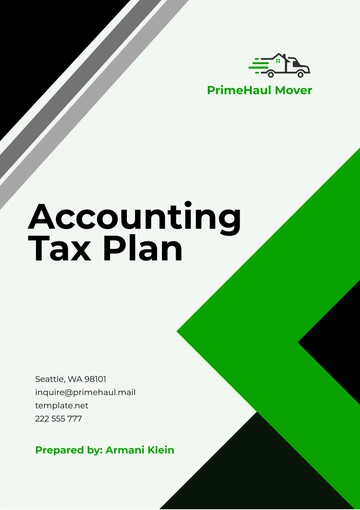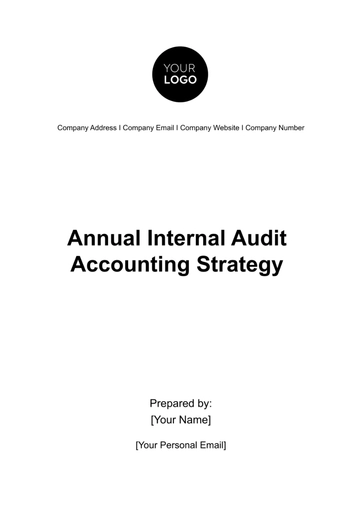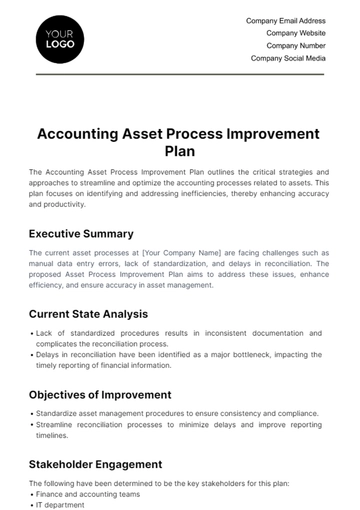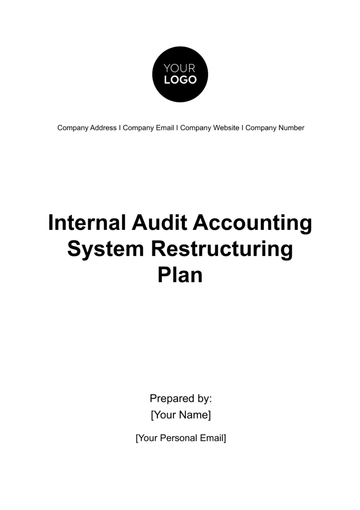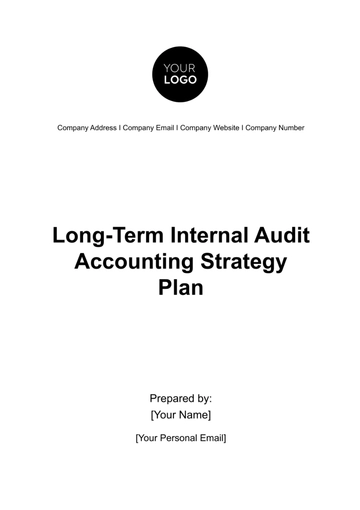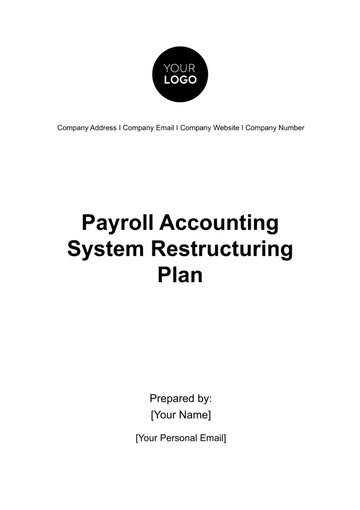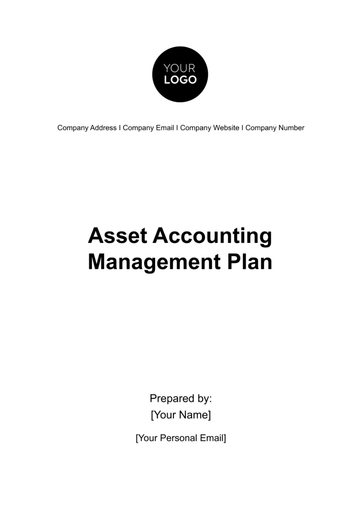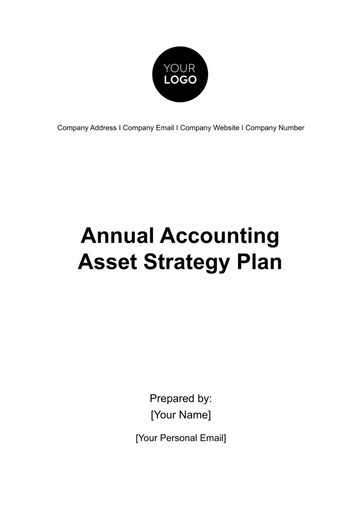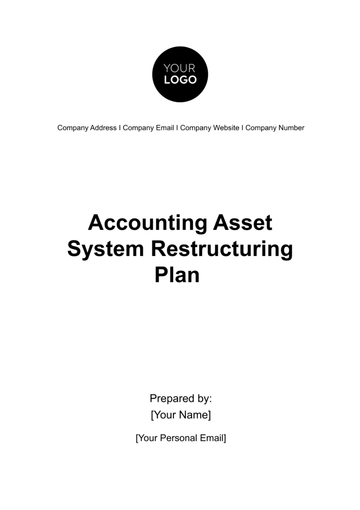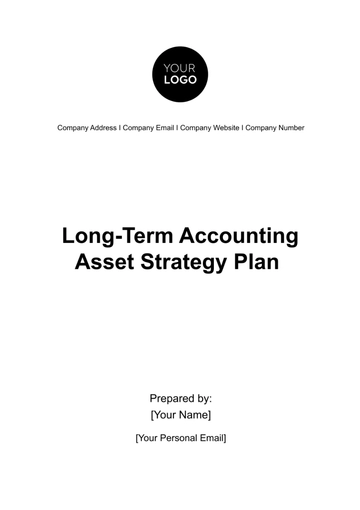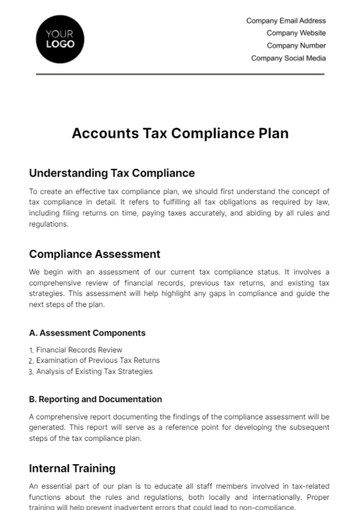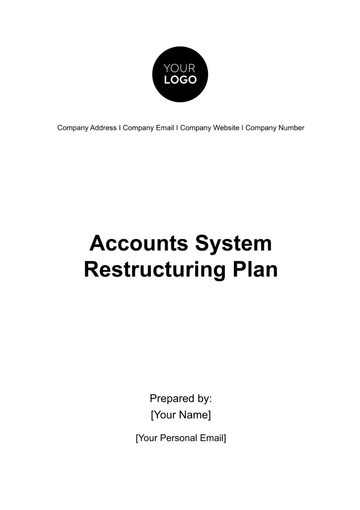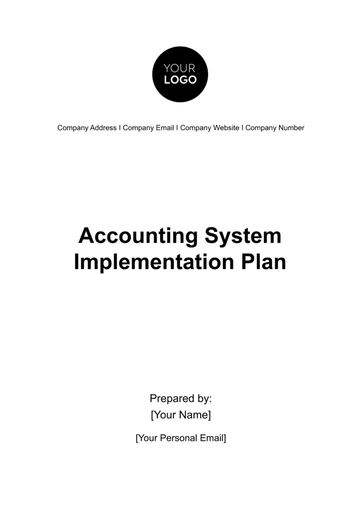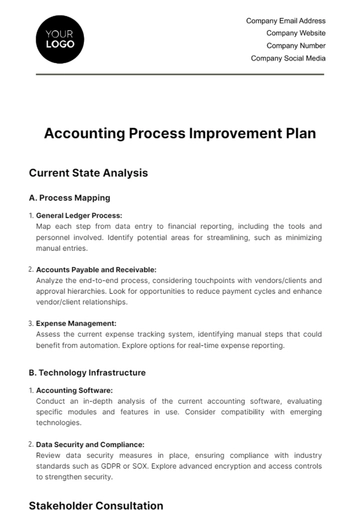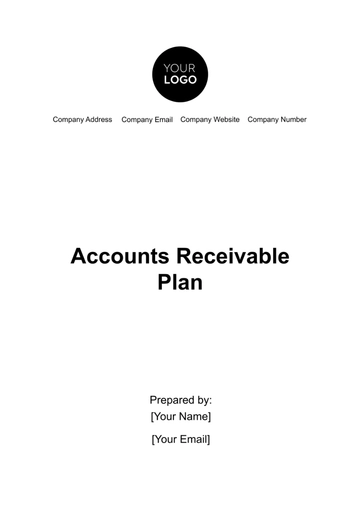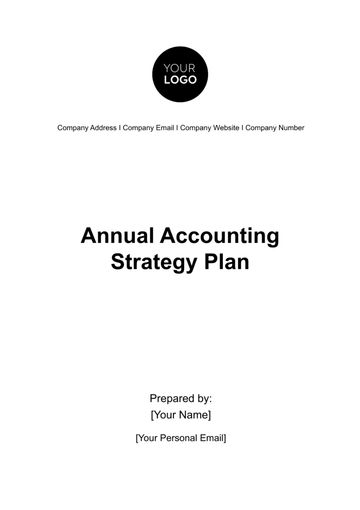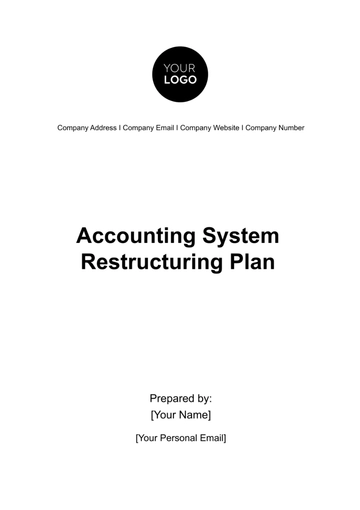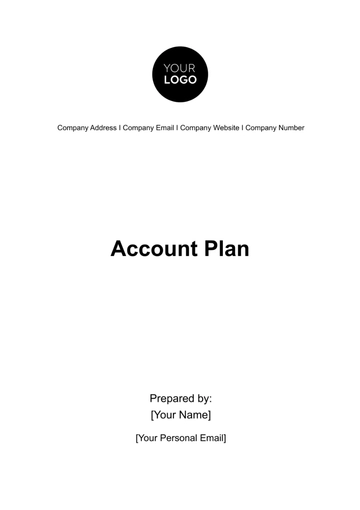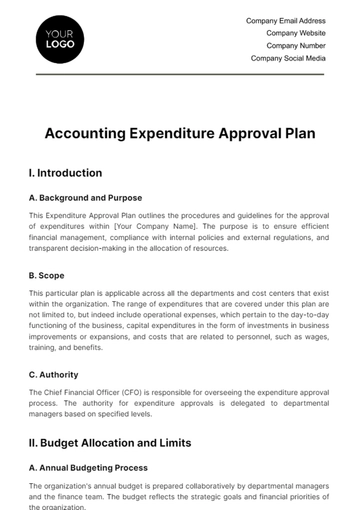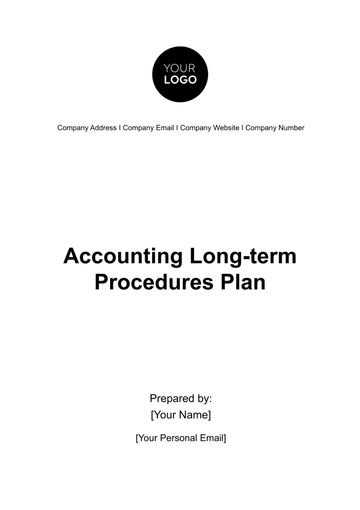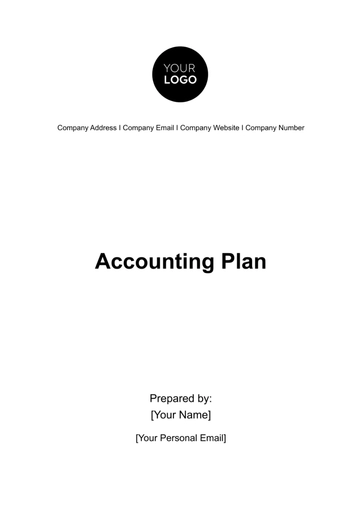Free Asset Accounting Management Plan

I. Introduction
Purpose of the AAMP
The Asset Accounting Management Plan (AAMP) serves as a strategic document to guide the effective management of [Your Company Name]'s assets. It outlines the organization's approach to asset accounting, maintenance, and disposal, ensuring alignment with financial objectives and regulatory requirements. By implementing the AAMP, [Your Company Name] aims to enhance transparency, accountability, and efficiency in asset management practices.
Scope and Applicability
The AAMP applies to all tangible and intangible assets owned or leased by [Your Company Name], including but not limited to equipment, buildings, IT assets, and land holdings. It encompasses all stages of the asset lifecycle, from acquisition to disposal, and is applicable across all departments and subsidiaries of the organization. The principles and guidelines outlined in the AAMP are designed to be flexible yet comprehensive, accommodating the diverse needs and operating environments within the organization.
Overview of the Organization's Asset Base
[Your Company Name] maintains a diverse portfolio of assets critical to its operations, encompassing physical infrastructure, technology systems, and other resources. The asset base includes assets acquired through capital expenditure as well as those obtained through leasing or other contractual arrangements. A comprehensive understanding of the organization's asset base forms the foundation for effective asset management strategies outlined in the AAMP.
II. Asset Inventory Management
Description of Asset Categories
Category | Description |
|---|---|
Equipment | Machinery, vehicles, computers, etc. |
Buildings | Office buildings, warehouses, facilities |
Furniture | Office furniture, fixtures, fittings |
IT Assets | Servers, software licenses, networking equipment |
Land | Land holdings owned by the organization |
Others | Other miscellaneous assets |
Procedures for Maintaining Asset Inventory
[Your Company Name] maintains an up-to-date asset register to record all acquisitions, disposals, and changes in asset status. Standardized procedures are in place for capturing relevant asset information, including descriptions, serial numbers, acquisition dates, and locations. Regular reconciliations between the asset register and physical asset counts are conducted to identify and address discrepancies promptly.
III. Depreciation Policies and Methods
Approved Depreciation Methods
Depreciation policies are established based on industry best practices and regulatory requirements. Straight-line depreciation is utilized for assets with predictable and linear decline patterns, while double-declining balance depreciation is employed for assets with accelerated depreciation characteristics. The selection of appropriate depreciation methods is guided by considerations such as asset type, usage patterns, and residual value expectations.
Criteria for Selecting Depreciation Method
[Your Company Name] considers various factors when selecting the most suitable depreciation method for each asset category. Straight-line depreciation may be preferred for assets with consistent usage and maintenance costs, providing a straightforward approach to expense allocation. On the other hand, double-declining balance depreciation may be chosen for assets with higher initial maintenance costs, allowing for accelerated write-offs and tax benefits.
IV. Maintenance and Upkeep
Maintenance Schedules
Asset Category | Maintenance Frequency | Responsible Department |
|---|---|---|
Equipment | Quarterly | Operations |
Buildings | Annually | Facilities Management |
IT Assets | Monthly | IT Department |
Others | As needed | Respective Departments |
Allocation of Resources
[Your Company Name] allocates resources for maintenance activities based on asset criticality, usage patterns, and historical maintenance data. Budgetary provisions are made for routine maintenance tasks as well as unforeseen repairs, ensuring adequate funding for asset upkeep. Cross-functional collaboration between maintenance teams and asset owners facilitates efficient resource allocation and timely resolution of maintenance issues.
V. Disposal Strategies
Criteria for Asset Disposal
Asset disposal decisions are guided by predefined criteria, considering factors such as asset condition, obsolescence, and strategic alignment with organizational goals. Assets reaching the end of their useful life or no longer contributing to operational efficiency are candidates for disposal. Regular assessments are conducted to identify surplus or underutilized assets eligible for disposition.
Methods of Asset Disposal
[Your Company Name] employs various disposal methods tailored to the characteristics of each asset and prevailing market conditions. Assets with residual value may be sold through public auctions or private sales, maximizing returns to the organization. Alternatively, donation or recycling options are pursued for assets with limited market value but potential societal or environmental benefits.
Procedures for Recording Asset Disposals
Disposal transactions are documented in accordance with established accounting standards and internal controls. Detailed records of disposal proceeds, write-off values, and associated expenses are maintained for financial reporting purposes. Proper documentation ensures transparency and accountability in the asset disposal process, facilitating accurate valuation and reporting of asset holdings.
VI. Risk Management
Identification of Risks
[Your Company Name] conducts comprehensive risk assessments to identify potential threats to asset integrity, including natural disasters, theft, technological obsolescence, and regulatory non-compliance. Risks are categorized based on their likelihood and impact, allowing for prioritization and targeted mitigation efforts. Regular reviews and updates to risk registers ensure alignment with evolving business needs and external factors.
Mitigation Strategies
Risk mitigation strategies are designed to minimize the likelihood and impact of identified risks, safeguarding [Your Company Name]'s assets and preserving business continuity. Proactive measures such as insurance coverage, security enhancements, and redundancy planning are implemented to mitigate operational disruptions and financial losses. Cross-functional collaboration and employee training programs promote awareness of risk management practices and encourage proactive risk mitigation efforts.
VII. Compliance and Reporting
Compliance with Accounting Standards
[Your Company Name] adheres to relevant accounting standards, such as Generally Accepted Accounting Principles (GAAP) or International Financial Reporting Standards (IFRS), to ensure accurate asset valuation and reporting. Compliance efforts extend to tax regulations governing asset depreciation, capitalization thresholds, and financial disclosures. Regular audits and reviews are conducted to assess compliance with accounting standards and identify areas for improvement.
Reporting Requirements
[Your Company Name] prepares and disseminates timely and accurate reports on asset-related information to internal and external stakeholders. Financial statements, including balance sheets, income statements, and cash flow statements, provide transparency into asset values and depreciation expenses. Additional reports may be generated for tax purposes, regulatory filings, or investor disclosures, highlighting significant changes in asset composition and valuation.
VIII. Cost Control and Budgeting
Budgeting Process
[Your Company Name] follows a systematic budgeting process to allocate resources for asset acquisition, maintenance, and disposal activities. Budgetary allocations are based on historical spending patterns, projected asset needs, and strategic priorities. Budget reviews and revisions are conducted periodically to reallocate resources in response to changing business conditions and emerging priorities.
Cost Control Measures
[Your Company Name] implements cost control measures to optimize asset-related expenditures and maximize the return on investment. Strategies include negotiating favorable terms with suppliers, consolidating procurement processes, and standardizing maintenance procedures to achieve economies of scale. Continuous monitoring of expenses and performance metrics enables proactive identification of cost-saving opportunities and the implementation of corrective actions.
IX. Asset Utilization and Optimization
Strategies for Maximizing Asset Utilization
[Your Company Name] employs proactive strategies to maximize asset utilization and productivity across its operations. This includes optimizing asset scheduling, implementing predictive maintenance techniques, and promoting efficient use of resources. Performance metrics such as asset uptime, utilization rates, and throughput are monitored closely to identify opportunities for improvement and resource reallocation. Additionally, cross-functional collaboration between asset managers, operations teams, and finance professionals facilitates data-driven decision-making and ensures alignment with organizational objectives. Regular performance reviews and benchmarking exercises enable [Your Company Name] to identify best practices and implement continuous improvement initiatives to further enhance asset utilization and optimize operational efficiency.
Identification of Underutilized Assets
Regular assessments are conducted to identify underutilized assets within [Your Company Name]'s portfolio. Factors such as asset usage patterns, maintenance history, and operational requirements are analyzed to determine the root causes of underutilization. Once identified, underutilized assets are evaluated for potential consolidation, redeployment, or divestment to optimize resource allocation and mitigate carrying costs. Cross-functional collaboration between asset managers, operations teams, and finance professionals facilitates data-driven decision-making and ensures alignment with organizational objectives. By implementing proactive strategies for asset utilization and optimization, [Your Company Name] aims to enhance operational efficiency, reduce costs, and maximize the return on investment from its asset base.
X. Lifecycle Management
Planning for Asset Lifecycle Stages
[Your Company Name] adopts a proactive approach to managing asset lifecycles, from acquisition to disposal. Asset lifecycle planning begins with the identification of future asset needs based on operational requirements and strategic objectives. This involves forecasting asset replacements or upgrades, evaluating alternative procurement options, and developing phased implementation plans to minimize disruption and maximize value realization.
Replacement and Upgrade Strategies
[Your Company Name] evaluates various factors when determining replacement and upgrade strategies for aging assets. Considerations include asset condition, technological advancements, regulatory requirements, and total cost of ownership (TCO) analysis. Phased replacement plans are implemented to prioritize critical assets and optimize capital expenditure allocations, ensuring alignment with budgetary constraints and organizational priorities.
XI. Roles and Responsibilities
Designation of Individuals or Departments
Clear roles and responsibilities are assigned to individuals and departments involved in asset management activities. The Finance Department oversees asset accounting and reporting processes, ensuring compliance with accounting standards and regulatory requirements. Operations teams are responsible for the maintenance and upkeep of operational assets, while IT departments manage IT assets and software licenses.
Collaboration Among Stakeholders
Effective collaboration among stakeholders is essential for the successful implementation of the AAMP. Regular communication channels are established to facilitate information sharing and decision-making processes. Cross-functional teams are formed to address asset-related challenges and opportunities, leveraging diverse expertise and perspectives to achieve common goals.
XII. Monitoring and Evaluation
Metrics for Assessing Effectiveness
[Your Company Name] utilizes key performance indicators (KPIs) to assess the effectiveness of asset management practices. Metrics such as asset uptime, maintenance costs per asset, and compliance with depreciation policies are monitored regularly to evaluate performance and identify areas for improvement. Benchmarking against industry standards and best practices provides context for performance assessments and informs continuous improvement efforts.
Monitoring Mechanisms
[Your Company Name] employs robust monitoring mechanisms to track asset performance and compliance with established policies and procedures. This includes regular audits of asset registers, physical asset counts, and maintenance logs to ensure accuracy and integrity of asset data. Periodic reviews of risk registers and compliance documentation help identify emerging risks and address gaps in control mechanisms proactively.
Periodic Review and Evaluation
The AAMP undergoes periodic review and evaluation to incorporate lessons learned and adapt to changing business needs. Annual reviews are conducted to assess the effectiveness of asset management strategies and identify opportunities for refinement. Feedback from stakeholders, including employees, customers, and regulatory authorities, is solicited to inform continuous improvement initiatives and enhance the AAMP's relevance and effectiveness.
XIII. Conclusion
The Asset Accounting Management Plan, developed by the [Your Company Name], establishes an all-inclusive blueprint for efficient management of assets within the organization's context. The intent behind this plan is to ensure that the principles and illustrative guidelines laid out in this document are strictly observed and followed. The overarching goal that [Your Company Name] is eager to achieve through the implementation of this plan is threefold: to optimize the use of resources, effectively limit potential risks, and fully augment the overall value of their assets. Alongside these goals, the organization also aspires to maintain an unwavering commitment to the high standards dictated by the principles of transparency, accountability and continuous improvement. By adhering steadfastly to these set principles, [Your Company Name] believes that the Asset Accounting Management Plan would remain an indispensable tool. This tool would aid in fulfilling organizational objectives and ensuring lasting success by realizing the organization’s vision in the long run. Hence, the plan merits continued commitment by the organization to ensure sustainable success for their long-term objectives.
- 100% Customizable, free editor
- Access 1 Million+ Templates, photo’s & graphics
- Download or share as a template
- Click and replace photos, graphics, text, backgrounds
- Resize, crop, AI write & more
- Access advanced editor
Discover seamless asset management with the Asset Accounting Management Plan Template from Template.net. This editable and customizable template, powered by an intuitive AI Editor Tool, streamlines financial strategies. Effortlessly tailor your plan to align with organizational goals. Elevate your asset accounting game with a template that adapts to your needs, ensuring precision and compliance.
You may also like
- Finance Plan
- Construction Plan
- Sales Plan
- Development Plan
- Career Plan
- Budget Plan
- HR Plan
- Education Plan
- Transition Plan
- Work Plan
- Training Plan
- Communication Plan
- Operation Plan
- Health And Safety Plan
- Strategy Plan
- Professional Development Plan
- Advertising Plan
- Risk Management Plan
- Restaurant Plan
- School Plan
- Nursing Home Patient Care Plan
- Nursing Care Plan
- Plan Event
- Startup Plan
- Social Media Plan
- Staffing Plan
- Annual Plan
- Content Plan
- Payment Plan
- Implementation Plan
- Hotel Plan
- Workout Plan
- Accounting Plan
- Campaign Plan
- Essay Plan
- 30 60 90 Day Plan
- Research Plan
- Recruitment Plan
- 90 Day Plan
- Quarterly Plan
- Emergency Plan
- 5 Year Plan
- Gym Plan
- Personal Plan
- IT and Software Plan
- Treatment Plan
- Real Estate Plan
- Law Firm Plan
- Healthcare Plan
- Improvement Plan
- Media Plan
- 5 Year Business Plan
- Learning Plan
- Marketing Campaign Plan
- Travel Agency Plan
- Cleaning Services Plan
- Interior Design Plan
- Performance Plan
- PR Plan
- Birth Plan
- Life Plan
- SEO Plan
- Disaster Recovery Plan
- Continuity Plan
- Launch Plan
- Legal Plan
- Behavior Plan
- Performance Improvement Plan
- Salon Plan
- Security Plan
- Security Management Plan
- Employee Development Plan
- Quality Plan
- Service Improvement Plan
- Growth Plan
- Incident Response Plan
- Basketball Plan
- Emergency Action Plan
- Product Launch Plan
- Spa Plan
- Employee Training Plan
- Data Analysis Plan
- Employee Action Plan
- Territory Plan
- Audit Plan
- Classroom Plan
- Activity Plan
- Parenting Plan
- Care Plan
- Project Execution Plan
- Exercise Plan
- Internship Plan
- Software Development Plan
- Continuous Improvement Plan
- Leave Plan
- 90 Day Sales Plan
- Advertising Agency Plan
- Employee Transition Plan
- Smart Action Plan
- Workplace Safety Plan
- Behavior Change Plan
- Contingency Plan
- Continuity of Operations Plan
- Health Plan
- Quality Control Plan
- Self Plan
- Sports Development Plan
- Change Management Plan
- Ecommerce Plan
- Personal Financial Plan
- Process Improvement Plan
- 30-60-90 Day Sales Plan
- Crisis Management Plan
- Engagement Plan
- Execution Plan
- Pandemic Plan
- Quality Assurance Plan
- Service Continuity Plan
- Agile Project Plan
- Fundraising Plan
- Job Transition Plan
- Asset Maintenance Plan
- Maintenance Plan
- Software Test Plan
- Staff Training and Development Plan
- 3 Year Plan
- Brand Activation Plan
- Release Plan
- Resource Plan
- Risk Mitigation Plan
- Teacher Plan
- 30 60 90 Day Plan for New Manager
- Food Safety Plan
- Food Truck Plan
- Hiring Plan
- Quality Management Plan
- Wellness Plan
- Behavior Intervention Plan
- Bonus Plan
- Investment Plan
- Maternity Leave Plan
- Pandemic Response Plan
- Succession Planning
- Coaching Plan
- Configuration Management Plan
- Remote Work Plan
- Self Care Plan
- Teaching Plan
- 100-Day Plan
- HACCP Plan
- Student Plan
- Sustainability Plan
- 30 60 90 Day Plan for Interview
- Access Plan
- Site Specific Safety Plan
